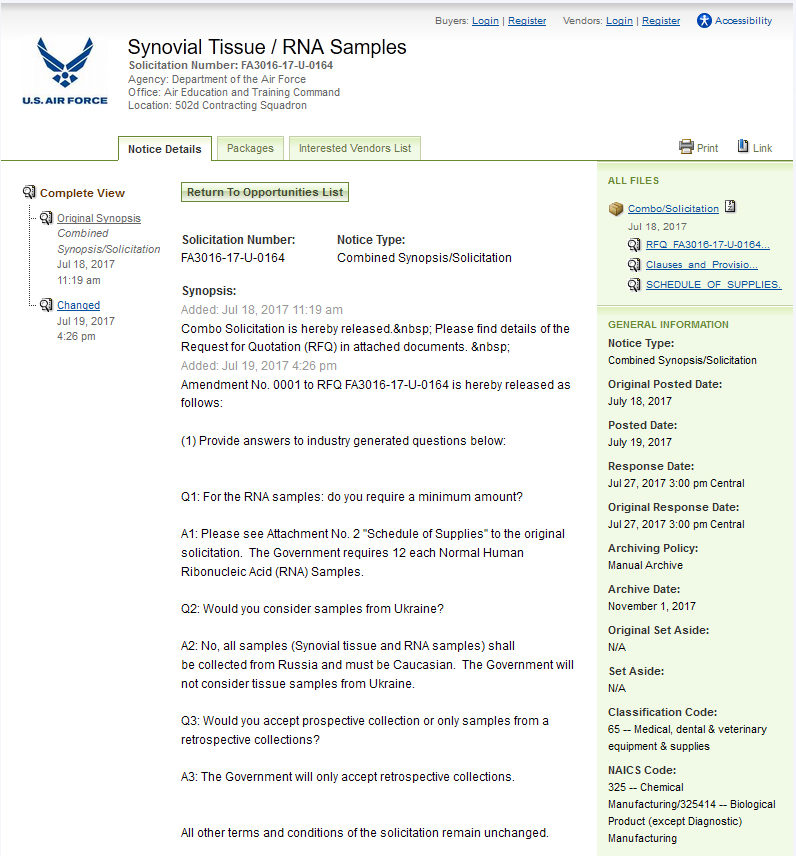
The documents suggest that the US's secretive Defense Advanced Research Projects Agency (Darpa) has become the world's largest funder of "gene drive" research and will raise tensions ahead of a UN expert committee meeting in Montreal beginning on Tuesday.
The UN Convention on Biological Diversity (CBD) is debating whether to impose a moratorium on the gene research next year and several southern countries fear a possible military application.
UN diplomats confirmed that the new email release would worsen the "bad name" of gene drives in some circles. "Many countries [will] have concerns when this technology comes from Darpa, a US military science agency," one said.
The technology is capable of splicing DNA strands in order to insert, alter, or remove targeted traits, and "drive" them through a population by ensuring all the offspring of the targeted organism inherit the alteration. Proponents of the gene-editing technology say it can be used to wipe out malaria-spreading mosquitoes, for example. Critics point out that the method could have unforeseen environmental consequences.
Comment: Many countries should have concerns about this news, particularly Russia. DARPA has a history of involving itself in some really creepy stuff.
- DARPA creates device that plugs directly into the visual cortex and alters DNA
- DARPA is developing an implant that can read brain signals in real-timeDARPA releases new KILSWITCH Android app that allows soldiers to kill people seven times faster than before
'Weaponizing viruses'? U.S. Air Force places ad for biological samples from RussiansIn the request, the US Air Force stated that "information on donors must be provided with the samples, including their sex, age, ethnicity, smoking history, medical history, height, weight and Body Mass Index (BMI)."
The US Air Force is looking to acquire samples of ribonucleic acid (RNA) and synovial fluid from Russians, according to a government website used to place tenders. The reason behind the order hasn't been specified.
The Air Force's Air Education and Training Command has placed a listing on the Federal Business Opportunities website asking for at least 12 RNA samples from Russian people of a European ancestry, as well as 27 samples of synovial fluid.
Russian president Putin may have hinted at this report while presiding over a meeting of Russia's Human Rights Council in late October 2017.
"Images are one thing, but do you know that biological material is being collected all over the country, from different ethnic groups and people living in different geographical regions of the Russian Federation? The question is - why is it being done? It's being done purposefully and professionally. We are a kind of object of great interest", Putin said.After the initial request was released by the US Air Force, member of the UN Commission on Biological Weaponry, Igor Nikulin told reporters:
"New types of biological weapons are being developed. There's nothing else that could possibly interest the military department. Most likely, they are weaponized viruses. The US is trying to develop various types of biological weapons specifically for specific carriers of this gene pool, and Caucasoids are needed since they constitute the majority of the population of our country. This is the same focus group for which they are trying to find the samples. It's necessary for the viruses to act selectively on one or another ethnic group."
The use of genetic extinction technologies in bioweapons is the stuff of nightmares, but known research is focused entirely on pest control and eradication.
Cutting-edge gene editing tools such as Crispr-Cas9 work by using a synthetic ribonucleic acid (RNA) to cut into DNA strands and then insert, alter or remove targeted traits. These might, for example, distort the sex-ratio of mosquitoes to effectively wipe out malarial populations.
Some UN experts, though, worry about unintended consequences. One told the Guardian: "You may be able to remove viruses or the entire mosquito population, but that may also have downstream ecological effects on species that depend on them."
"My main worry," he added, "is that we do something irreversible to the environment, despite our good intentions, before we fully appreciate the way that this technology will work."
Jim Thomas, a co-director of the ETC group which obtained the emails, said the US military influence they revealed would strengthen the case for a ban.
"The dual use nature of altering and eradicating entire populations is as much a threat to peace and food security as it is a threat to ecosystems," he said. "Militarisation of gene drive funding may even contravene the Enmod convention against hostile uses of environmental modification technologies."
Gene-drive research has been pioneered by an Imperial College London professor, Andrea Crisanti, who confirmed he has been hired by Darpa on a $2.5m contract to identify and disable such drives.
Fears that the research could be channeled towards bioweapons were "all fantasy", he said. "There is no way this technology could be used for any military purpose. The general interest is in developing systems to contain the undesired effects of gene drives. We have never been asked to consider any application not for the good of eliminating plagues."
Interest in the technology among US army bureaus has shot up since a secret report by the elite Jason group of military scientists last year "received considerable attention among various agencies of the US government", according to an email by Gerald Joyce, who co-chaired a Jason study group in June.
A second Jason report was commissioned in 2017 assessing "potential threats this technology might pose in the hands of an adversary, technical obstacles that must be overcome to develop gene drive technology and employ it 'in the wild'," Joyce wrote.




Comment: So on the one hand the idea that the research could be used for bioweapons is dismissed as fantasy, while another report assessed the "potential threats the technology might pose in the hands of an adversary".